Discover Florida Nature
It's time to explore the natural Florida


|
|
|
|
|
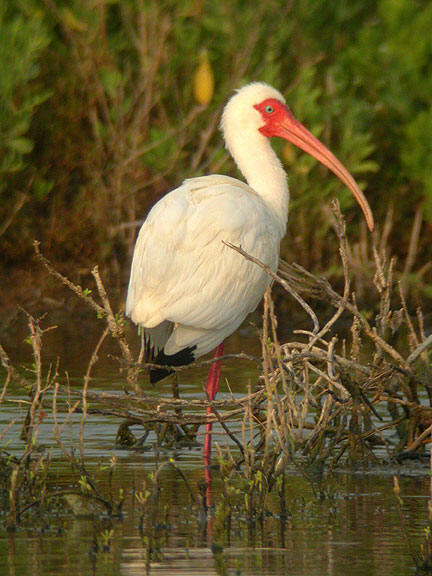 White
Ibis- The white ibis about two feet tall and has a wingspan of
about three feet. It is entirely white except for its black-edged wings.
Its blacked tipped wings may not be noticeable when the ibis is at rest,
but are easily seen when it is in flight. It has a long, down-curved
reddish-orange bill and a reddish-orange face. It legs are long and
gray, except for during breeding season when they turn reddish-orange.
Young white ibis are brown on their upper sides and white on their
undersides and they have brown bills and legs. The white ibis wades in
the water sweepings its heads form side-to-side in search of food. It
uses its long, curved bill to probe in the mud for crabs and crayfish.
It swallows its prey whole. It also forages for food on land and it may
also eat insects, frogs, snails, marine worms, snakes and small fish.
Flocks of white ibis will move to different locations in search of food.
Other wading birds often follow behind the white ibis and catch prey
that has been disturbed by the probing ibis! White
Ibis- The white ibis about two feet tall and has a wingspan of
about three feet. It is entirely white except for its black-edged wings.
Its blacked tipped wings may not be noticeable when the ibis is at rest,
but are easily seen when it is in flight. It has a long, down-curved
reddish-orange bill and a reddish-orange face. It legs are long and
gray, except for during breeding season when they turn reddish-orange.
Young white ibis are brown on their upper sides and white on their
undersides and they have brown bills and legs. The white ibis wades in
the water sweepings its heads form side-to-side in search of food. It
uses its long, curved bill to probe in the mud for crabs and crayfish.
It swallows its prey whole. It also forages for food on land and it may
also eat insects, frogs, snails, marine worms, snakes and small fish.
Flocks of white ibis will move to different locations in search of food.
Other wading birds often follow behind the white ibis and catch prey
that has been disturbed by the probing ibis!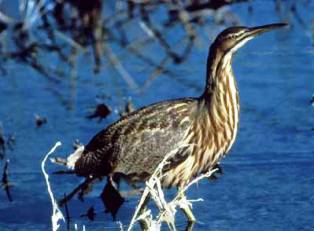 American
Bittern- The bittern, a species of heron, spends its life among
tall, aquatic vegetation like cattails or sawgrass, in freshwater and
saltwater marshes or at the borders of lakes. It stands over two feet
tall. Its color - a buff brown back, creamy underparts with brown
flecking, greenish legs - allows it to blend with the surroundings, as
does its behavior. To remain concealed when alarmed, the bird freezes
with its head pointed skyward, resembling reeds. If wind stirs the
vegetation, the bittern may also sway its head. Sun-gazer, the American
bittern is called, as well as Stake Driver, Thunder Pump and Mire Drum.
The names refer to the bittern's call, a deep resonant oonk-a-lunk,
which has been likened to the bellowing of a bull or a hydraulic
machine. It's odd that a bird this secretive makes such a racket. Since
the bittern is a winter visitor to Florida, we rarely hear its weird
vocalizations, mostly made during the spring and summer. American
bittern occur throughout Florida November through April, mostly in
freshwater marshes, before returning to the northern U.S. and southern
Canada to breed. Their numbers have been declining over the past three
decades at an average rate of 2.4 percent per year, mostly due to loss
of wetlands. American
Bittern- The bittern, a species of heron, spends its life among
tall, aquatic vegetation like cattails or sawgrass, in freshwater and
saltwater marshes or at the borders of lakes. It stands over two feet
tall. Its color - a buff brown back, creamy underparts with brown
flecking, greenish legs - allows it to blend with the surroundings, as
does its behavior. To remain concealed when alarmed, the bird freezes
with its head pointed skyward, resembling reeds. If wind stirs the
vegetation, the bittern may also sway its head. Sun-gazer, the American
bittern is called, as well as Stake Driver, Thunder Pump and Mire Drum.
The names refer to the bittern's call, a deep resonant oonk-a-lunk,
which has been likened to the bellowing of a bull or a hydraulic
machine. It's odd that a bird this secretive makes such a racket. Since
the bittern is a winter visitor to Florida, we rarely hear its weird
vocalizations, mostly made during the spring and summer. American
bittern occur throughout Florida November through April, mostly in
freshwater marshes, before returning to the northern U.S. and southern
Canada to breed. Their numbers have been declining over the past three
decades at an average rate of 2.4 percent per year, mostly due to loss
of wetlands.
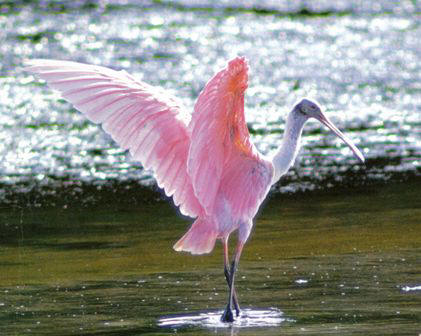 Roseate
Spoonbill-
Prior to the 1850s, there were probably thousands of spoonbills along
the Gulf Coast in Texas, Louisiana and Florida. By 1920, plume hunting
and colony disturbance largely depleted the spoonbill population in the
United States. Is it the luminous pale pink plumage with red highlights
or the long bill with the spoon shaped tip that so enchants those lucky
enough to view this long-legged wader that is a member of the ibis
family? The spatulate bill of this species has an important function. It
has sensitive nerve endings that help the spoonbill detect prey. As it
sweeps the bill from side to side through shallow water, the spoonbill
encounters small fish, shrimp, crayfish, fiddler crabs and aquatic
insects, which it snaps up and swallows. Roseate
Spoonbill-
Prior to the 1850s, there were probably thousands of spoonbills along
the Gulf Coast in Texas, Louisiana and Florida. By 1920, plume hunting
and colony disturbance largely depleted the spoonbill population in the
United States. Is it the luminous pale pink plumage with red highlights
or the long bill with the spoon shaped tip that so enchants those lucky
enough to view this long-legged wader that is a member of the ibis
family? The spatulate bill of this species has an important function. It
has sensitive nerve endings that help the spoonbill detect prey. As it
sweeps the bill from side to side through shallow water, the spoonbill
encounters small fish, shrimp, crayfish, fiddler crabs and aquatic
insects, which it snaps up and swallows.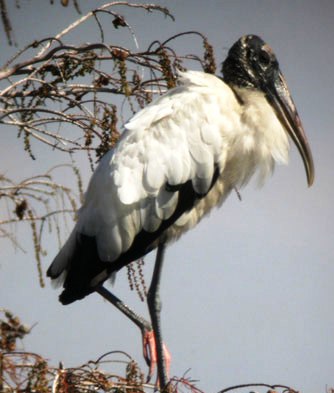 Wood
Stork-
Tall and long-legged, the wood stork is the largest wading bird native
to America. It is white with black flight feathers, distinctive because
of its dark, featherless head (down to the upper neck) and thick,
down-curved bill. Wood storks fly with neck and legs extended,
interrupting strong wing beats with brief glides; their wingspan is 5
1/2 feet. Wood storks usually feed within 16 miles of their colony but
often fly great distances in search of feeding grounds, sometimes as
much as 60-80 miles. To feed, the wood stork typically wades in shallow
water, stirring the muddy bottom with its flesh-colored feet and
partially opened bill. Once a small fish contacts the interior of the
beak, it is snapped shut in 1/40 second, one of the fastest reflex
actions known. This is known as grope feeding and its success depends
upon dense populations of small fish. Wood storks forage, or feed in
drying wetlands, which concentrate prey. It is estimated that the
average stork family requires 443 pounds of fish during the breeding
season. Wood
Stork-
Tall and long-legged, the wood stork is the largest wading bird native
to America. It is white with black flight feathers, distinctive because
of its dark, featherless head (down to the upper neck) and thick,
down-curved bill. Wood storks fly with neck and legs extended,
interrupting strong wing beats with brief glides; their wingspan is 5
1/2 feet. Wood storks usually feed within 16 miles of their colony but
often fly great distances in search of feeding grounds, sometimes as
much as 60-80 miles. To feed, the wood stork typically wades in shallow
water, stirring the muddy bottom with its flesh-colored feet and
partially opened bill. Once a small fish contacts the interior of the
beak, it is snapped shut in 1/40 second, one of the fastest reflex
actions known. This is known as grope feeding and its success depends
upon dense populations of small fish. Wood storks forage, or feed in
drying wetlands, which concentrate prey. It is estimated that the
average stork family requires 443 pounds of fish during the breeding
season.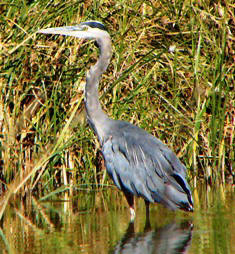 Great
Blue Heron- The largest and most widespread heron in North
America, the Great Blue Heron can be found along the ocean shore or the
edge of a small inland pond. An all white form is found from southern
Florida into the Caribbean, and used to be considered a separate
species, the "Great White Heron." The white form of the Great Blue
Heron, known as the "great white heron," is found nearly exclusively in
shallow marine waters along the coast of very southern Florida, the
Yucatan Peninsula, and in the Caribbean. Where the dark and white forms
overlap in Florida, intermediate birds known as "Wurdemann's herons" can
be found. They have the bodies of a Great Blue Heron, but the white head
and neck of the great white heron. Although the Great Blue Heron eats
primarily fish, it is adaptable and willing to eat other animals as
well. Several studies have found that voles (mice) were a very important
part of the diet, making up nearly half of what was fed to nestlings in
Idaho. Occasionally a heron will choke to death trying to eat a fish
that is too large to swallow. Great
Blue Heron- The largest and most widespread heron in North
America, the Great Blue Heron can be found along the ocean shore or the
edge of a small inland pond. An all white form is found from southern
Florida into the Caribbean, and used to be considered a separate
species, the "Great White Heron." The white form of the Great Blue
Heron, known as the "great white heron," is found nearly exclusively in
shallow marine waters along the coast of very southern Florida, the
Yucatan Peninsula, and in the Caribbean. Where the dark and white forms
overlap in Florida, intermediate birds known as "Wurdemann's herons" can
be found. They have the bodies of a Great Blue Heron, but the white head
and neck of the great white heron. Although the Great Blue Heron eats
primarily fish, it is adaptable and willing to eat other animals as
well. Several studies have found that voles (mice) were a very important
part of the diet, making up nearly half of what was fed to nestlings in
Idaho. Occasionally a heron will choke to death trying to eat a fish
that is too large to swallow. |
|
|
Advertise | Privacy Statement | Dog Encyclopedia | Video |Contact | Alaska Nature |
|